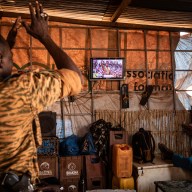Colleen Boudreau lies awake at night worrying not about her mortgage or car payments, but how she’s going to put food in her five-year-old daughter’s belly or clothes on her back.
She earns around $1,500 a month on disability welfare, which leaves her — at best — $50 after bills, she said.
“Sometimes I fear I can’t properly support my own daughter,” said Boudreau, who lives in a subsidized housing unit in the Downtown Eastside and is moving this week to nearby Strathcona.
She said it would “take a lifetime” to save the money to visit family back East, and little things like hockey and ballet lessons are out of the question.
“The stress of that makes you tired,” she said.
Boudreau is one of 500,000 British Columbians — or 13 per cent of the population — living in poverty, which in Vancouver equates to an hourly income of around $16 or less, according to a report published by the Canadian Centre For Policy Alternatives.
Boudreau says she can’t afford to survive outside the DTES.
“If you try to (move) … it’s even worse because it’s a reminder of what you can’t have, or what you will not be, or that you don’t fit in.”
“I can’t get out of the cycle of poverty, I am stuck in it for life,” said Boudreau.
Deborah Irvine, vice president of Community Impact and Investments with the United Way in Vancouver, said the issues surrounding poverty are complex, but have to do with access to nutritious food, affordable and safe housing, and an ability to budget.
“I think there’s a tendency for people to blame (those) who are poor and to look at it as a sort of never ending continuum … Even in poor neighbourhoods there are rich community assets,” she said.
Irvine said giving at-risk kids support and stability will help end the cycle of poverty by giving them “a strong start.”
With files from Stig Nielsen
















